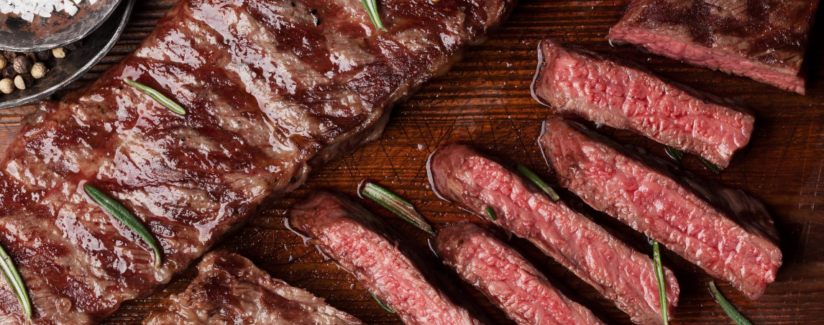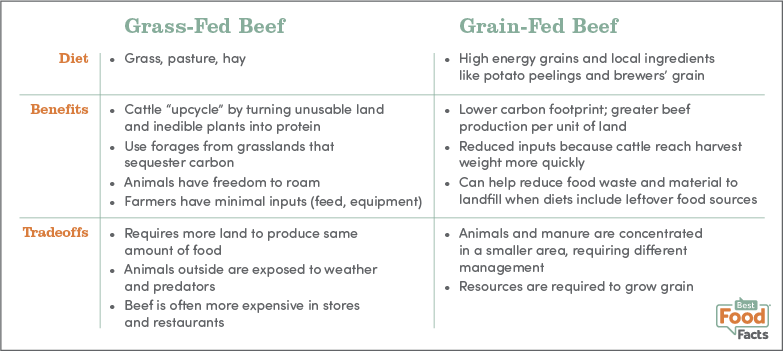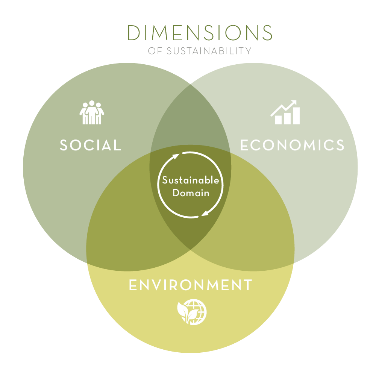
Sustainability: Can Eating Beef Be Sustainable?
08/28/2020
Sustainable food is important to many people, including farmers and food producers. As Best Food Facts has explored the complexity of food production decisions, we’ve looked at the dimensions of sustainability, pesticide use and GMOs. Learn more about optimizing sustainability.
This fourth post in our series examines the methods used to raise and feed cattle for beef. Most beef cattle live in grass pastures most of their lives. After calves are weaned from their mothers, they may either be “grass fed” or “grain fed” and sometimes a combination of these two methods.
Tradeoff
Dr. Tara Felix, beef specialist with Penn State Extension, explains the difference between the two methods in an online video, which looks at the benefits and tradeoffs from a farmer perspective.
Grass-fed beef comes from cattle raised primarily on grass, pasture or hay. Some grass-fed beef programs include non-grain products, such as soyhull pellets and others. Grain-fed beef comes from cattle who are fed a diet of high-energy grains, which includes corn, soy meal and other ingredients. Grain-fed beef may also be called corn-fed.
Grass-fed versus Grain-fed Beef: What’s the Difference?
 Learn more about What Do Cows Eat?
Learn more about What Do Cows Eat?
Questions around the sustainability of beef have recently been raised, as studies have examined the greenhouse gas emissions linked to livestock and beef production. An article by Tamar Haspel in the Washington Post explained some of the key considerations and noted there are many connected factors, including methane emissions, manure management, specific feeding and cropping practices, and more. “Some grass-fed cattle are better for the planet than some grain-fed, and vice versa,” Haspel states.
“No matter what strategy you choose, there are always trade-offs,” Dr. Rattan Lal, director of the Carbon Management and Sequestration Center at Ohio State University, stated in the article.
We reached out to Dr. Jason Rowntree, associate professor in animal science at Michigan State University, who is conducting research to better understand sustainable ways to raise cattle. Dr. Rowntree became interested in the topic while he was researching beef cattle at Louisiana State University. He and his family lived in Baton Rouge when Hurricanes Katrina and Rita caused extensive damage to the area and many farms.
“I began thinking about the resiliency of our food system. We do have a solid food system, but I wanted to find out how to make our food system better and more resilient,” he said. “For any system to be sustainable long-term, it’s got to be something we can sustain environmentally, it has to be profitable, and it’s got to be a system that can be supported socially.”
 Some conversations about beef production sustainability involve greenhouse gas emissions linked to livestock and beef production.
Some conversations about beef production sustainability involve greenhouse gas emissions linked to livestock and beef production.
“There’s always balance to this discussion,” Dr. Rowntree said. “We understand that science is revealing the fact that we have made some mistakes in how we grow food. We’ve been addressing things strictly from volume perspective. We are learning about actions that have a better impact on the environment and contribute to food security.”
About 80 percent of beef in the United States is grain-fed. Because the animals receive a high-energy diet, they reach their final weight faster, which reduces the amount of land and water required.
“If we want more land for wildlife and recreation, it means we have less land to grow food on. If we have less land to grow food on, we then focus on how to be more intense and efficient, which can have deleterious effects to the environment. A balance is needed,” Dr. Rowntree said.
His current research is looking at ways to improve grass-fed beef operations. On the research farm, Dr. Rowntree and his colleagues study various practices, such as working to add carbon to the soil, increasing biodiversity and selecting cattle with genetics best suited for grass feeding. The results have been promising.
“As our land has gotten better, we can run more cows on less land and with fewer inputs. Our research has actually shown we can produce beef with a net carbon sink to the environment,” Dr. Rowntree said.
But, he noted that there are tradeoffs. “Grass-fed does require more land to produce the same amount of food. You can’t have your cake and eat it too.”
He is hopeful that the research will find ways to reduce costs for beef farmers, which can support affordable beef for consumers, help farmers be profitable and improve the long-term sustainability of farming.
“Ranchers are people. Farming families are people. Farmers have to feed their family day in and day out,” he said of his work to improve farmers’ livelihoods.
Both grain-fed and grass-fed systems can be sustainable, Dr. Rowntree believes. He said there are many misunderstandings about beef production. For instance, not all grain that is raised goes into animal feed, because much of it is used for other purposes. Research has shown that cows do not produce as much methane gas as was once believed.
“Cows are ruminants, which means they can upcycle nutrients from plants that we can’t. They eat grass from untillable ground, so grazing cows are not taking away from land to grow crops,” he said.
Beef cattle are either grass-fed or grain-fed. Grass-fed beef takes more time and requires more land to produce the same amount of food, while grain-fed beef concentrates animals in smaller areas and requires land and water to grow crops. Both methods of raising beef can be sustainable from the perspective of the environment, animal well-being and farmer livelihood.



























